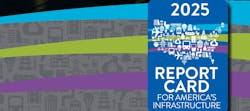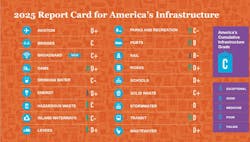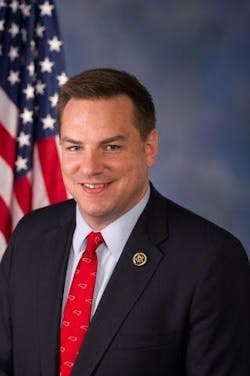What is the ASCE report card?
Every four years, the American Society of Civil Engineers' (ASCE) Report Card for America's Infrastructure evaluates the condition and performance of American infrastructure in a familiar school report card format, assigning letter grades based on the physical condition and necessary investments for improvement. According to ASCE, America's cumulative GPA is a C up from C minus in 2021, the highest it has ever been. The organization noted that, for the first time since 1998, no category received a D-minus grade.
As more consumer and business operations have migrated online, the need for a solid broadband connection has never been more critical. However, according to the American Society of Civil Engineers’ (ASCE) 2025 Report Card for America’s Infrastructure, there is room for improvement.
Being the first year ASCE had a broadband chapter, the segment received a C+ grade.
Broadband availability has increased steadily over the past 25 years. Consider that in 2000, only 1% of U.S. households had broadband access, compared to 80% by 2025.
This progress is due to ongoing investments in new broadband infrastructure, including a mix of hybrid fiber coax (HFC), fiber-to-the-home (FTTH), as well as Fixed Wireless Access (FWA) and emerging satellite technologies. (See sidebars on FTTH growth and quarterly broadband equipment spending)
Since 1996, the US Telecom industry association has reported in its investment report that private investment in broadband has reached nearly $2.2 trillion. Meanwhile, the Infrastructure Investment and Jobs Act (IIJA) allocated $65 billion to enhance broadband access, enabling more people to connect online.
ASCE noted that if there had been no progress in expanding broadband, it would have stunted economic progress. Research has shown that the U.S. would have lost $1.3 trillion in economic growth between 2010 and 2020 if broadband speeds and adoption had remained at 2010 levels.
Darren Olson, the chair of the Committee on America’s Infrastructure, stated that the reason it was included in this year’s infrastructure report is that broadband has become a vital tool for people to communicate. Still, it also serves other essential infrastructure needs.
“Broadband is the infrastructure, a system of systems, and is one of the things that connects all these systems,” he said. “It is so integral to our daily lives and to other infrastructure networks that it made sense to include it this year.”
Broadband adoption, affordability challenges
Despite the progress service providers have made in extending broadband to more homes and businesses, the broadband gap persists.
As recently as 2022, the FCC estimated that 24 million Americans lacked access to wireline broadband services, including 28% of those in rural areas and more than 23% living on tribal lands.
The ASCE noted that, despite a high availability rate, approximately 15% of U.S. adults lack a home broadband connection.
“There are still 12.7 million people who don’t have a broadband subscription,” Olson said. “It will be a matter of capturing the remaining people, given the vital importance of broadband.”
One of the primary barriers to broadband adoption is the combination of affordability and access.
According to a Pew Trust article, all 50 states that created digital equity plans under the Digital Equity Act planning grant program in 2021 identified the lack of affordable access as the leading barrier to digital equity in their state plans.
In particular, the states planned to use digital equity funds to address the needs of low-income households, people over 60, incarcerated individuals, veterans, people with disabilities, individuals for whom English is not a first language, racial and ethnic minorities, and people living in rural areas.
A large majority of states focused their digital equity efforts on the Affordable Connectivity Program (ACP), a federal subsidy that provides low-income households with up to $30 per month ($75 on Tribal lands) to help pay for broadband service. However, funding for the ACP ended in May 2024, so states could leverage other subsidies.
Pew said price is only one issue that affects broadband affordability.
“Lack of digital skills and devices may also pose barriers to an affordable connection,” wrote Pew. "People in households that are not connected may struggle to access affordable broadband offers and require assistance with signing up for low-cost services, accessing devices, and learning digital skills."
The BEAD factor
Another key factor that the U.S. government has implemented to enhance the reach of broadband is the $42.45 billion Broadband Equity, Access, and Deployment (BEAD) Program.
The program aims to connect 25 million Americans currently without broadband access.
However, critics of the program argue that the rules to get funding are too onerous and have not fulfilled its promise to connect more people and communities with broadband service.
Earlier this month, Congressman Richard Hudson (R-NC), who serves as Chairman of the Communications and Technology Subcommittee on the House Energy and Commerce Committee, led Republican members of the subcommittee in introducing the Streamlining Program Efficiency and Expanding Deployment (SPEED) for the BEAD Act.
"Too many Americans lack broadband access," said Chairman Hudson in a release announcing the new initiative. "Yet, not a cent of the BEAD funds has been put towards actual deployment for even one household. This is unacceptable. Our rural communities need to be fully connected, and this legislation will help achieve that goal.
The SPEED for BEAD Act has garnered support from multiple broadband-related industry organizations, including: ACA Connects, the Fiber Broadband Association, INCOMPAS, NTCA - The Rural Broadband Association, USTelecom, WISPA, and NCTA - The Internet & Television Association.
Among the proposals the program puts forward is the use of any technology and the allocation of funds for deployment and workforce development.
Even though the technology agnostic approach might help drive more deployment, Parks Associates noted that ending the preference for fiber might mean some communities will have to leverage wireless and satellite services, which lack the speed and resiliency of fiber.
“The incoming administration is pushing for changes to BEAD policy, particularly the preference for fiber connectivity,” Parks said in its Top Five Takeaways from the Broadband Market Tracker. “These policy changes are likely to negatively impact fiber deployments in BEAD-eligible areas, further shifting the market toward wireless and satellite connectivity, which are less expensive to deploy.”
Nevertheless, the other key challenge for service providers will be labor and network equipment costs.
The build-out will require an additional 205,000 employees over the next five years. This will likely be a challenge as more technicians retire, forcing service providers to find ways not only to attract new technicians but also to provide the necessary training to meet broadband deployment build-out plans.
ASCE estimates that it will cost $61 billion to meet the BEAD program’s stated goal of universal broadband availability for every American by 2030, with federal capital investments estimated to total $42.5 billion over that same period.
“If current funding levels continue, the nation is well-positioned to meet today’s needs,” ASCE said. "However, deployment costs are increasing, with some firms seeing costs rise by over 10% for deployment, with materials and labor costs being the most significant drivers of the increase."
For related articles, visit the Business Topic Center.
For more information on high-speed transmission systems and suppliers, visit the Lightwave Buyer’s Guide.
To stay abreast of fiber network deployments, subscribe to Lightwave’s Service Providers and Datacom/Data Center newsletters.
Fiber broadband passed 10.3M homes in 2024
Driven by new deployments from a range of Tier 1 and Tier 2 incumbents, as well as numerous new competitive providers, fiber broadband buildouts continue to ramp up. A recent Fiber Broadband Association Fiber Deployment survey, conducted in collaboration with RVA Market Research & Consulting (RVA), revealed that fiber broadband deployments reached a new annual record of 10.3 million U.S. homes passed in 2024. Survey data suggest that fiber now passes 56.5% of U.S. households. Also, fiber take rates increased slightly in 2024, growing to an average of over 45% based on unique passings. Service providers are achieving their first 20% take rate much faster and reaching higher take rates over time.
Broadband equipment rebounded in 2H 2024, but future growth will be challenging
With the inventory correction completed in the second half of the year, a new Dell’Oro report revealed that total global revenue for the Broadband Access equipment market increased to $4.8 billion in the fourth quarter of 2024, up 3% sequentially and 5% year-over-year. However, the research firm noted that the progress made in the fourth quarter, as well as the gains in the second half of the year, were not enough to push 2024 into positive territory. Furthermore, broadband spending for the year remained flat compared to 2023.
“The first half of 2024 saw continued inventory corrections from 2023, while the second half of the year saw a return to more consistent and predictable purchasing,” said Jeff Heynen, VP at Dell’Oro Group.
He added that while “2025 was supposed to be a growth year for the Broadband market. However, continued high capital and labor costs, global economic uncertainty, and delays in DOCSIS infrastructure equipment all threaten to hamper growth.
About the Author
Sean Buckley
Sean is responsible for establishing and executing the editorial strategy of Lightwave across its website, email newsletters, events, and other information products.



